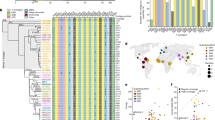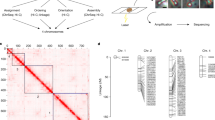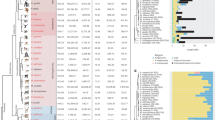Abstract
The human Y chromosome is composed of two different parts: a pseudoautosomal region shared with the X chromosome which is responsible for sex chromosome pairing and a Y-specific part that encodes the sex determining gene1. Previously we have shown that the pseudoautosomal gene MIC2 only rarely recombines between the sex chromosomes and, based on the elevated recombination rates in the pseudoautosomal region, we predicted that this gene would lie close to the Y-specific region2. In this report we describe a test of this prediction using long-range restriction mapping techniques. We conclude that MIC2 is less than 200 kilobases (kb) away from Y-specific sequences. During these experiments we have identified an HTF island in a position consistent with the proposed location of the human sex determining gene.
This is a preview of subscription content, access via your institution
Access options
Subscribe to this journal
Receive 51 print issues and online access
$199.00 per year
only $3.90 per issue
Buy this article
- Purchase on Springer Link
- Instant access to full article PDF
Prices may be subject to local taxes which are calculated during checkout
Similar content being viewed by others
References
1. Burgoyne, P.S. Hum. Genet. 61, 85–90 (1982). 2. Goodfellow, P. J., Darling, S. M., Thomas, N. S. & Goodfellow, P. N. Science 234, 740–743 (1986). 3. Rouyer, F. et al. Nature 319, 291–295 (1986). 4. Mondello, C., Ropers, H–H., Craig, I. W., Tolley, E. & Goodfellow, P. N. Ann. hum. Genet. 51, 137–143 (1987). 5. Ferguson–Smith, M. A. Lancet ii, 475–476 (1966). 6. De la Chapelle, A. Hum. Genet. 58, 105–116 (1981). 7. Petit, C. et al Cell 49, 595–602 (1987). 8. Vergnaud, G. et al. Am. J. hum. Genet. 38, 109–124 (1986). 9. Affara, N. A. et al Nucleic Acids Res. 14, 5375–5387 (1986). 10. Geldwerth, D. et al EMBO J. 4, 1739–1743 (1985). 11. Affara, N. A. et al Nucleic Acids Res. 14, 5352–5373 (1986). 12. Pritchard, C. A., Goodfellow, P. J. & Goodfellow, P. N. Nucleic Acids Res. (in the press). 13. Schwartz, D. C. & Cantor, C. R. Cell 37, 67–75 (1984). 14. Carle, G. F. & Olsen, M. V. Nucleic Acids Res. 12, 5647–5664 (1984). 15. Renwick, J. H. Brit. med. Bull 25, 65–73 (1969). 16. Brown, W. R. A. & Bird, A. P. Nature 322, 477–481 (1986). 17. Geller, R. L., Shapiro, L. J. & Mohandas, T. K. Am. J. hum. Genet. 38, 884–890 (1986). 18. Goodfellow, P. J. Pritchard, C. Tippett, P. & Goodfellow, P. N. Ann. hum. Genet. 51, 161–167 (1987). 19. Goodfellow, P., Darling, S. & Wolfe, J. J. med. Genet. 22, 329–344 (1985). 20. Sirota, L., Zlotogora, Y., Shabtai, F., Halbrecht, I. & Elian, E. Clin. Genet. 19, 87–93 (1981). 21. Bernards, A., Kooter, J. M. Michels, P. A. M. Moberts, R. M. P. & Borst, P. Gene 42, 313–322 (1986). 22. Feinberg, A. P. & Vogelstein, B. Analyt. Biochem. 132, 6–13 (1983).
Author information
Authors and Affiliations
Rights and permissions
About this article
Cite this article
Pritchard, C., Goodfellow, P. & Goodfellow, P. Mapping the limits of the human pseudoautosomal region and a candidate sequence for the male-determining gene. Nature 328, 273–275 (1987). https://doi.org/10.1038/328273a0
Received:
Accepted:
Issue Date:
DOI: https://doi.org/10.1038/328273a0
This article is cited by
-
Cloning of PBDX, an MIC2-related gene that spans the pseudoautosomal boundary on chromosome Xp
Nature Genetics (1994)
-
A sterile male with 45,X0 and a Y;22 translocation
Human Genetics (1991)
-
A gene from the human sex-determining region encodes a protein with homology to a conserved DNA-binding motif
Nature (1990)
-
Localization of the human GM-CSF receptor gene to the X–Y pseudoautosomal region
Nature (1990)
-
The pseudoautosomal boundary in man is defined by an Alu repeat sequence inserted on the Y chromosome
Nature (1989)
Comments
By submitting a comment you agree to abide by our Terms and Community Guidelines. If you find something abusive or that does not comply with our terms or guidelines please flag it as inappropriate.



